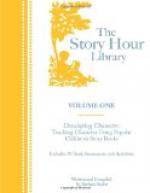Here is the place where we remarked impressively, “A lie, children, is the very worst thing in the world!” whereupon Billy interrogated, with wide eyes and awed voice, “Is it worse than A Railroad crossing?” And there is a sentence in the story of the “Bird’s Nest” sacred to the memory of Tommy’s tear!—Tommy of the callous conscience and the marble heart. Tommy’s dull eye washed for one brief moment by the salutary tear! Truly the humble Story-Teller has not lived in vain. Sing, ye morning stars, together, for this is the spot where Tommy cried!
If you would be the Person with a Story, you must not only have one to tell, but you must be willing to learn how to tell it, if you wish to make it a “rememberable thing” to children. The Story-Teller, unlike the poet, is made as well as born, but he is not made of all stuffs nor in the twinkling of an eye. In this respect he is very like the Ichneumon in the nonsense rhyme:—
“There once was an idle Ichneumon
Who thought he could learn to play
Schumann;
But he found, to his pains,
It took talent and brains,
And neither possessed this Ichneumon.”
To be effective, the story in the kindergarten should always be told, never read; for little children need the magnetism of eye and smile as well as the gesture which illuminates the strange word and endows it with meaning. The story that is told is always a thousand times more attractive, real, and personal than anything read from a book.
Well-chosen, graphically told stories can be made of distinct educative value in the nursery or kindergarten. They give the child a love of reading, develop in him the germ, at least, of a taste for good literature, and teach him the art of speech. If they are told in simple, graceful, expressive English, they are a direct and valuable object lesson in this last direction.
The ear of the child becomes used to refined intonations, and slovenly language will grow more and more disagreeable to him. The kindergartner cannot be too careful in this matter. By the sweetness of her tone and the perfection of her enunciation she not only makes herself a worthy model for the children, but she constantly reveals the possibilities of language and its inner meaning.
“The very brooding of a voice on a word,” says George Macdonald, “seems to hatch something of what is in it.”
Stories help a child to form a standard by which he can live and grow, for they are his first introduction into the grand world of the ideal in character.
“We live by Admiration, Hope, and Love; And even as these are well and wisely fixed, In dignity of being we ascend.”
The child understands his own life better, when he is enabled to compare it with other lives; he sees himself and his own possibilities reflected in them as in a mirror.
They also aid in the growth of the imaginative faculty, which is very early developed in the child, and requires its natural food. “Imagination,” says Dr. Seguin, “is more than a decorative attribute of leisure; it is a power in the sense that from images perceived and stored it sublimes ideals.” “If I were to choose between two great calamities for my children,” he goes on to say, “I would rather have them unalphabetic than unimaginative.”




